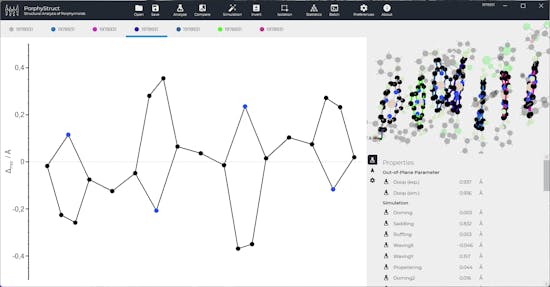PorphyStruct - Structural Analysis of Porphyrinoids
J. Krumsieck, M. Bröring Poster
ICPP-12, 10.07.2022 - 15.07.2022 in Madrid.
JCF JungChemikerTagung, 20.04.2023 in Braunschweig.

While the non-planar displacements of Porphyrins and their consequences on both chemical and physical properties were investigated using the NSD Method, such a method did not exist for other porphyrinoids, like Corroles, for a long time. With PorphyStruct such analyses are possible for Porphyrins, Corroles, Norcorroles, Corrphycenes and Porphycenes and their structuraal relatives. A Minimal and Extended Basis of reference structures is available for each of those macrocyclic types. In most cases the minimal basis is sufficient to describe the conformation.
Important Information:
- J. Krumsieck, M. Bröring, Chem. Eur J., 2021, 27, 11580-11588, DOI:10.1002/chem.202101243
- Download (Windows) and Sourcecode can be found on GitHub
- Web-based Version of PorphyStruct
- Website and Documentation (PorphyStruct.org)

The Conformational Periodic Table of Corroles
Systematic studies of the structures of corroles known from the literature are now possible. First analyses indicate dependencies on central atom, substitution pattern and non-innocence characteristics. Doming, saddling and ruffling modes are often found side by side, and waving modes are more salient than within porphyrin structures. The overall commonnes of modes follows their energetic order in the calculated reference. For comparability, the analyses were performed with the extended basis and a composite value (comp) was calculated for each of the 6 modes.
Copper-Corroles are SUPERSADDLED!
Supersaddling is a phenomenon exclusive for coinage metal complexes (mostly Cu). These complexes are the only ones that exhibit an extremely strong saddling2 contribution in addition to saddling1. This structural pattern results from an antiferromagnetic coupling of the Cu 3d(x2-y2) electron with the corrole π-radical. The minimal basis therefore can not describe these complexes.





